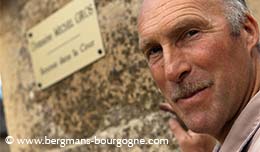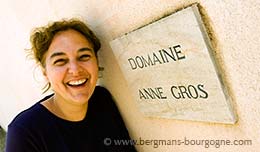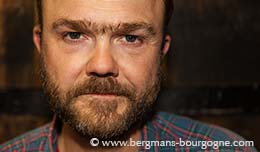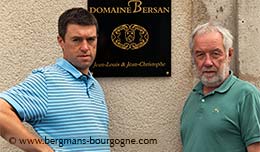
aison Sarnin-Berrux is a rare bird in Burgundy. This négociant based in Saint-Romain has decided to produce only natural wines. Starting out in 2007 with a modest production of white wine only Jean-Pascal Sarnin and Jean-Marie Berrux now have an annual production of about 15 000 bottles in both colours. But it is not easy to make natural wines in this part of the world. The supply of organically grown grapes is very limited.
– They are very difficult to find, says Jean-Pascal Sarnin. Only a small part of the winegrowers in Burgundy work organically. While traditional winegrowers sell a lot of grapes these winegrowers usually bottle and sell everything themselves, so they have no grapes to sell. The organic domaines are also often smaller than the traditional domaines and therefore produce less.
Maison Sarnin-Berrux first came to life in 2007. Jean-Pascal Sarnin had left his job in finance in Paris in order to be closer to his family in Saint-Romain. But finding a job in finance outside Paris is not easy, so changes had to be made. He moved from being chief financial officer at one of the major stockbrokers on the Paris stock exchange, to running his own négociant business in Saint-Romain, a village with some 250 inhabitants six kilometres northeast of Meursault.

Jean-Marie Berrux has a somewhat similar background. Having worked in communication and advertising he left in 1999 for a career in wine.
– He worked with a winemaker in Arbois, in Jura, explains Jean-Pascal Sarnin. And he fell in love with wine. He stayed there for a year and then came to Beaune for wine school. After that he worked for a winemaker in Saint-Romain for eight years, so he has a lot of experience, both in the vineyards and in the cellar.
Today the two of them have nine wines in their portfolio. Seven of these are village appellations – Beaune and Saint-Romain in both colours, white Meursault, white Saint-Aubin and white Savigny-lès-Beaune – and there is a Bourgogne rouge as well as a vin de table made from grenache. In addition to that Jean-Marie Berrux produces a white Bourgogne – "Le Petit Têtu" – from his own vineyard.

– You could make traditional from organic grapes, but that would be such a waste, says Jean-Pascal Sarnin. We use organic grapes and then use a natural process to make the wine – no enzymes, no yeast, no filtration. We just use a little bit of sulphites, in fact the minimum, just before the bottling to protect the wine during transport and cellaring.
They buy everything as grapes. Organically grown grapes are scarce, and being a new name on the market does not exactly help.
– It is difficult, says Jean-Pascal Sarnin. I'm not Burgundian. Jean-Marie is not a Burgundian guy either. But we are very serious about what we do, and with a lot of hard work, it becomes easier. Buying grapes is the easiest when you start out. Buying vineyards is very expensive and complicated when it comes to rules and habits.
– There are three criteria for how we choose the appellations we work with – what's easy to sell, the quality of the appellation and our own preferences. We try to mix these three; but it is not always easy.
– For example we have the appellation Beaune, both red and white. This is not easy to sell. But we like the wine ourselves, and when you do that you are more convinced to sell. Then you have the opposite, with Pommard and Puligny-Montrachet, which are very easy to sell.
Natural wine
There is no established certification body and the term has no legal status. Most definitions of natural wine include some or all of the following:
- Hand-picked, organically or biodynamically grown grapes.
- Low-yielding vineyards.
- No added sugars, no foreign yeasts.
- No fining or filtration.
- No adjustments for acidity.
- No other additives for mouth-feel, colour, etc.
- No micro-oxygenation or reverse osmosis.
- Little or no added sulphite.
– Saint-Romain, where we are located, has a good potential. It's a small appellation – 140 hectares split equally between chardonnay and pinot noir. The altitude of the vineyards varies between 300 and 400 metres. The soil is stony calcareous clay. There are no premiers crus today, but there is work being done in order to have certain plots upgraded.
 Jean-Pascal Sarnin explains that they want to interfere as little as possible, in order to preserve the maximum taste and to keep the character of the terroir.
Jean-Pascal Sarnin explains that they want to interfere as little as possible, in order to preserve the maximum taste and to keep the character of the terroir.
– I think natural wines have purer taste, he says. And they are also better for your health. Sulphites are poison for humans, so we want a product that is as clean as possible. The acceptable daily intake for an adult is 25 mg.
– Making natural wines involves more difficulties. They are more sensitive. Diseases affect them more easily. In traditional winemaking, when you add chemical products to the wine at the beginning of the vinification process you kill all microorganisms. A natural wine does not have this kind of protection, so you have to work very carefully. You have to keep the temperature in the cellar very low, around 12°C–15°C. You have to clean all the equipment very carefully, especially the barrels and the tanks. And in order to make sure that your wines are doing OK in the barrels you have to taste every week.
Natural wine is not a big thing in Burgundy. It is more common in the Loire valley and in the south of France. In 2008 1210 hectares, 4,3 percent of the total surface area, were worked organically – viticulture biologique – in Burgundy.
– There is a growing interest from the consumers, he says. There is a big market in Paris and some in Lyon and Marseille. Outside France you Japan, which is a very important market for natural wine. Apart from Japan we also export to Canada and Belgium. And before the end of the year we expect to start working with Switzerland and the US.
© 2009 Ola Bergman














